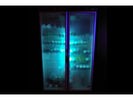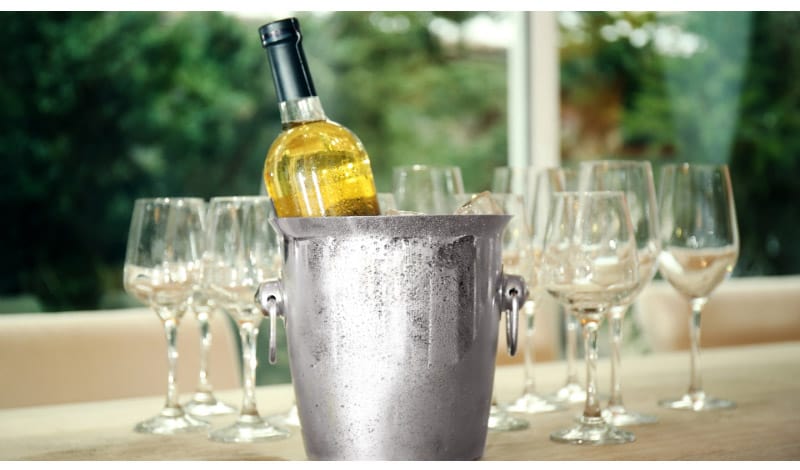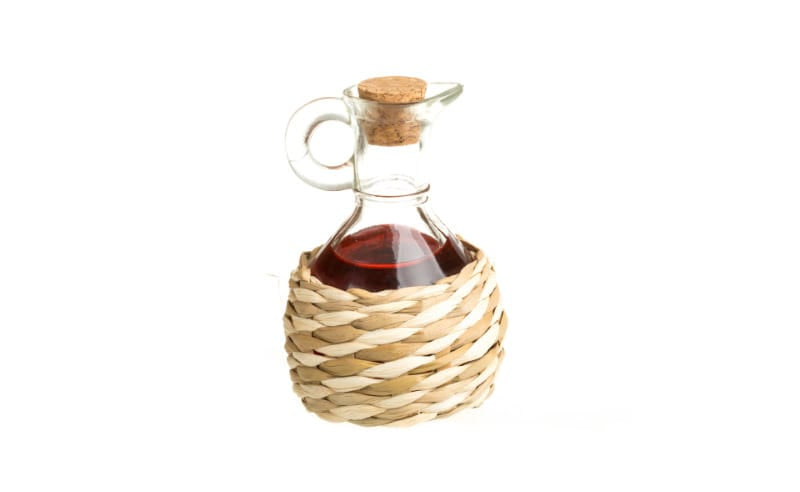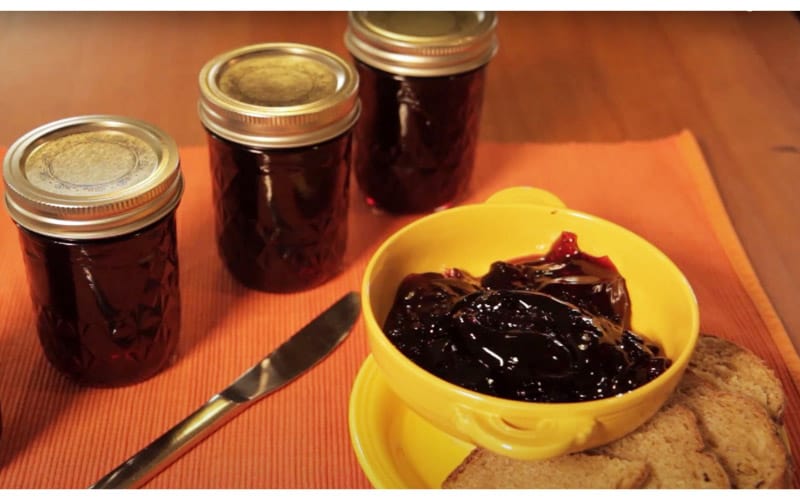
What Temperature Does Wine Freeze? Tips For Freezing Wine


Maybe you accidentally left your wine in the freezer or you’re wondering, does wine freeze? Yes, it does. Its freezing temperature depends on the alcohol content. But usually, wine gets icy cold at about 22°F or -5.6°C.
In this article, we will answer all questions related to frozen wine. We also listed some tips and ideas for freezing wine effectively, so read on to learn more about it.
Wine freezes and it is safe to drink. However, freezing your wine is not something that you should always do because it changes the beverage’s taste, especially red wine.
When your wine is exposed to extremely low temperatures, its acid content is converted into insoluble tartar crystals that alter the drink’s flavor. These crystals also release carbon dioxide, thus producing a “geyser” effect similar to a champagne shower. So if you don’t want that, it’s better to avoid freezing wine.
Also, a wine that freezes also expands and might push out the cork or the bottle’s stopper. You might think that’s good since you don’t need to use a corkscrew or wine opener anymore, but it has some adverse effects.
A more dangerous scenario is that the bottle of wine might break, and the shards could hurt you. Freezing wine can also cause it to oxidize or experience freezer burn, degrading its quality.
As mentioned, frozen wine expands and removes the cover or seal of the bottle, making the alcoholic beverage prone to oxidation.
Typically, a wine aerator or decanter oxidizes the wine quickly in the right environment. But if oxidation is prolonged, it will affect the taste of the wine. Extreme oxidation may also turn wine into vinegar. That’s why you should use a wine preservation system to prevent this from happening.

Just like oxidation, when the wine becomes too exposed to air, it can experience freezer burn. This occurs when the water from the wine is removed due to the cold temperature.
Wine aging is a good idea but do it somewhere else rather than in the freezer. If the wine is stored there for too long, its aroma and flavor profile will completely change. The tannins and alcohol in the wine might also be altered, making it unsuitable for drinking or cooking.
The freezing temperature of your wine depends on the amount of alcohol in it. The higher the concentration of alcohol, the lower its freezing point is.
The University of Illinois created a chart showing the freezing point of wine relative to its ethanol content. You may use this table to know exactly what temp does wine freeze.
|
% Ethanol |
Freezing Point (°F) |
Freezing Point (°C) |
|
0 |
32 |
0 |
|
10 |
25 |
-4 |
|
20 |
15 |
-9 |
|
30 |
5 |
-15 |
|
40 |
-10 |
-23 |
|
50 |
-25 |
-32 |
|
60 |
-35 |
-37 |
|
70 |
-55 |
-48 |
|
80 |
-75 |
-59 |
|
90 |
-110 |
-73 |
|
100 |
-175 |
-115 |
Since the average alcohol content of wine is 12.5%, its freezing point is approximately 22°F or -5.6°C. Please note that this freezing point may change due to sulfites and other compounds that may affect the wine.
If ever you decide to answer the question: “Does wine freeze?” Here are some tips to best freeze your wine.
A standard kitchen freezer has a temperature of 0°F or -17.8°C. And since the average freezing point of wine is around 22°F or -5.6°C, placing the bottle inside the freezer for about 5 hours (or more) will definitely solidify it.
However, if you place a bottle of wine inside a freezer with precisely the same temperature as its freezing point, it will not turn solid.
Since the freezing point of water is less than those of the alcohol, the water molecules will be the first to freeze. As the alcohol molecules are left behind and accumulate, their freezing point lowers.
That’s why it becomes slushy in appearance rather than pure solid. So if you want to purely solidify your wine, place it in a freezer that has a lower temperature than its freezing point.
Since wine expands when frozen, it would be best to avoid sealed glass containers or other vessels that do not allow expansion.
You can pour your wine in silicone ice cube trays. Then, place it in a zip lock bag or wrap with plastic wrap, and put it inside the freezer. Another option is to make use of plastic containers that are freezer-safe and have screw-on lids.

This is an excellent alternative to chilling wine because you will not worry about forgetting the bottle in the freezer. You just need to fill your bucket with water and ice cubes, then add salt.
Salt is necessary because it will decrease the melting point of the ice, thus letting you reap its benefits longer.

Since adding ice cubes to your wine dilutes the drink, it is better to add frozen grapes. This will not spoil the beverage and instead enhance its flavor. This method not only chills your wine but also improves your drinking experience.
You may put your bottle of wine inside the refrigerator for a short time and wait for it to chill. Red wine requires about 45 minutes of freezing time to cool thoroughly, while white wine takes about an hour.
Here is a video showing the different methods of chilling wine without freezing it:
There are other uses of chilled or frozen wine besides drinking it. Here are some ideas:
This is one of the most common ways to use frozen wine. It has three kitchen applications: cooking liquid, marinade ingredient, and flavoring.
Wine is used to enhance the aroma and flavor of your dishes. It doesn’t mask the taste but intensifies it instead. Use only the appropriate amount of wine. Too little will barely have an effect, while too much is overpowering.
It would be best to freeze the wine in ice cube trays for easy measurement. An ice cube is about two tablespoons of wine, so you would just need to estimate how many ice cubes you need.
Our suggested amount of wine depends on the food you want to cook, but here are some standard measurements that you can use:
Here is a video of how frozen wine is used in cooking:

As stated previously, too much wine oxidation can turn it into vinegar. Red and white wines can both be used for vinegar production.
It will be handy in the kitchen as salad and meat dressing, marinade, seasoning, and pickling. Wine vinegar is also commonly used in some Mediterranean cuisines. Learn more about how to make vinegar.
Sangria is a delicious Spanish drink made from red wine, fruit, sugar, and brandy. It is an excellent addition to any party or even a small celebration with friends.
A tasty way to make use of frozen wine is to turn it into slushies. It has two varieties that you can both try.
Pro Tip: Some types of wine take longer to freeze, so be cautious and keep it frozen for a long time.

Jellies are not only for kids; they are also for adults who love wine. So besides making slushies, why not try your hand at wine jellies?
Pro Tip: Leave a headspace of about ½ inch
Here is a video showing the step-by-step process of creating jellies from wine:
The answer to the question, “does wine freeze?” is more complicated than we think. Wine’s freezing temperature depends on the amount of alcohol in it and other factors.
However, it’s better if you don’t freeze your wine because it changes its taste and quality. But if you accidentally forgot your bottle of wine in the freezer, there are still many delightful ways you can use it, such as making slushies or using it for cooking.
Did you find this article helpful? Share your thoughts in the comments.

